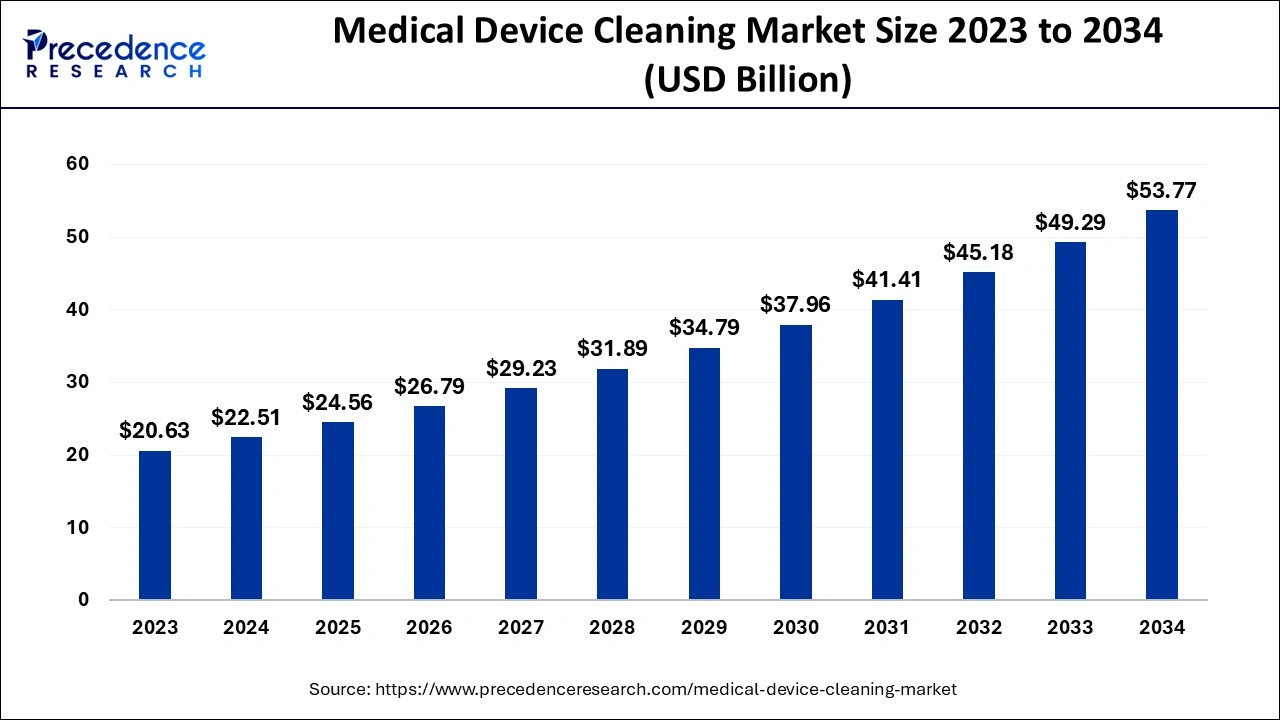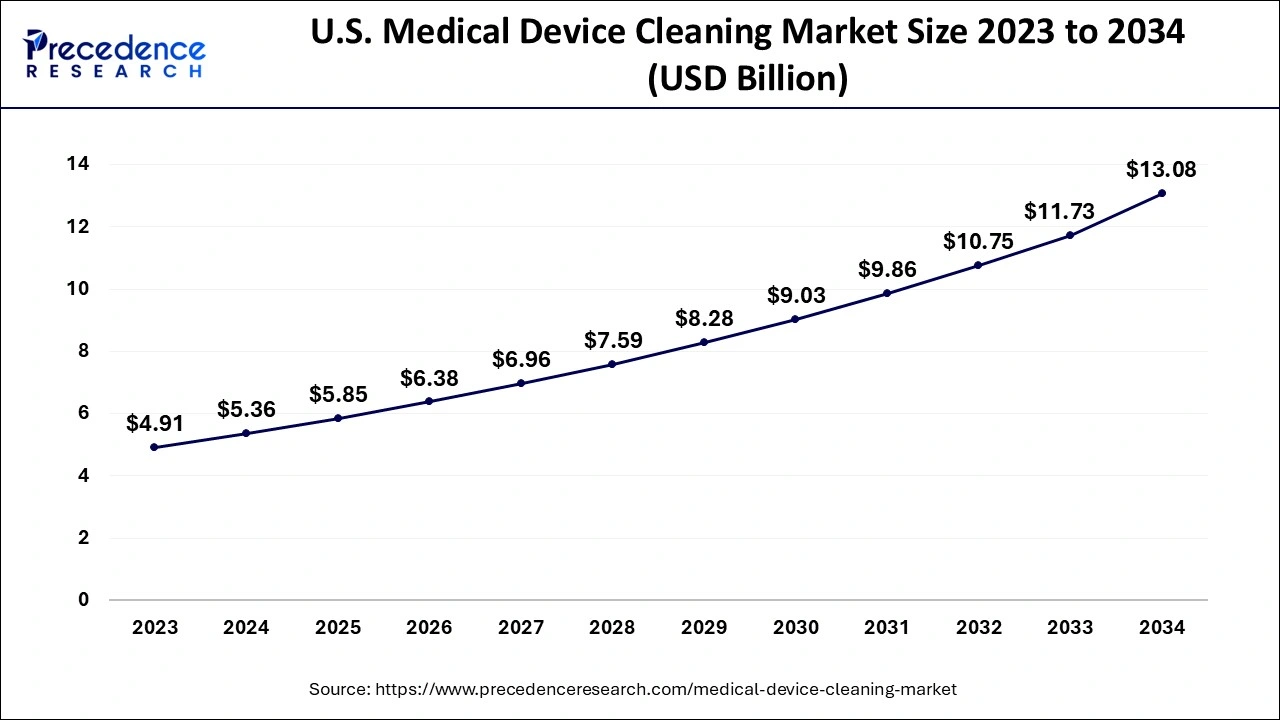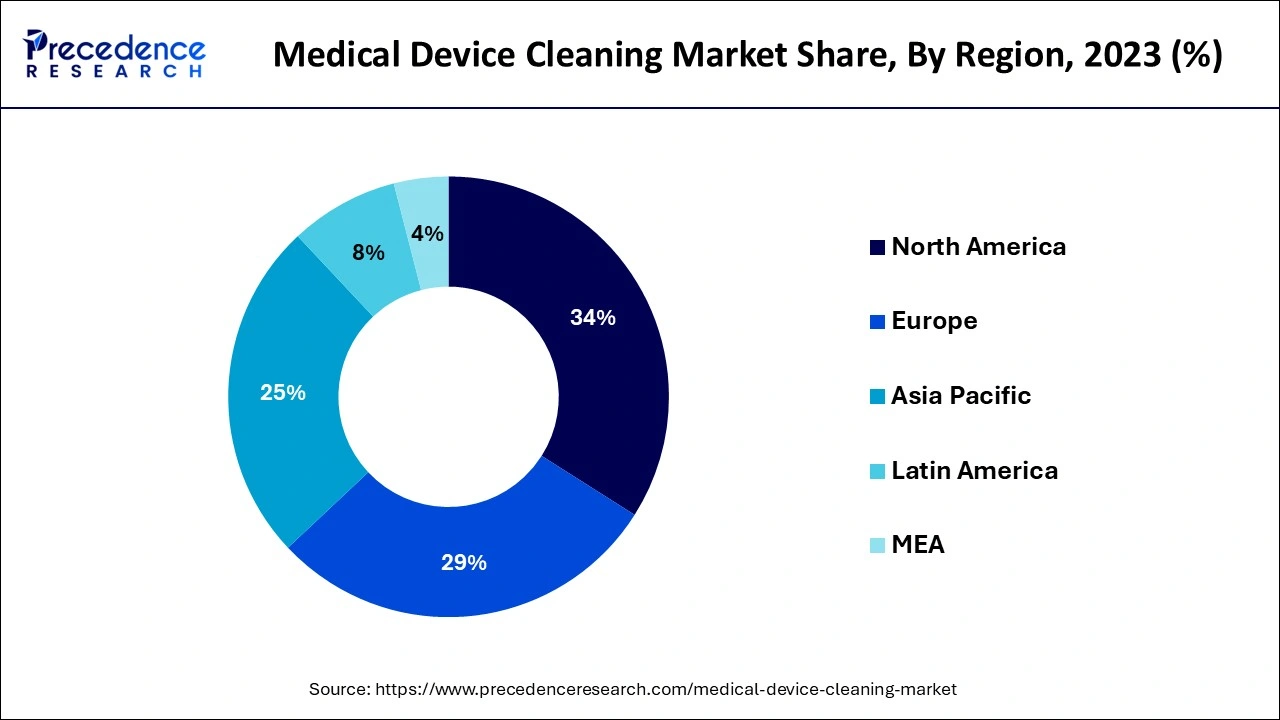January 2025
The global medical device cleaning market size accounted for USD 22.51 billion in 2024, grew to USD 24.56 billion in 2025 and is predicted to surpass around USD 53.77 billion by 2034, representing a healthy CAGR of 9.10% between 2024 and 2034. The North America medical device cleaning market size is calculated at USD 7.65 billion in 2024 and is expected to grow at a fastest CAGR of 9.25% during the forecast year.
The global medical device cleaning market size is estimated at USD 22.51 billion in 2024 and is anticipated to reach around USD 53.77 billion by 2034, expanding at a CAGR of 9.10% from 2024 to 2034.

The U.S. medical device cleaning market size is evaluated at USD 5.36 billion in 2024 and is predicted to be worth around USD 13.08 billion by 2034, rising at a CAGR of 9.32% from 2024 to 2034.

In terms of revenue in 2023, North America represented a decisive 34% of the market for cleaning medical devices. The greater market share that the area is expected to capture is attributed to the major market players' consistent implementation of strategic collaborations to increase their product offerings and infection prevention and control capabilities. Throughout the course of the forecast period, tight government regulations governing the disinfecting and cleaning of medical equipment as well as favorable reimbursement policies are also projected to boost the market in the region for medical device cleaning. Two key factors driving the growth of sterile procedures are the increased usage of non-disposable medical equipment and the increasing desire to reduce costs related to hospital-acquired illnesses.

Due to the region's substantial outsourcing presence, rising healthcare spending, and impressive growth of healthcare infrastructure and standards, it is estimated that the market for cleaning medical devices would grow significantly in Asia Pacific over the projected period. Additionally driving market development in this sector are the Covid-19 pandemic and the spread of infectious infections. One of the primary drivers of market growth is the existence of several nonprofit and governmental organizations dedicated to raising infection control standards.
There will be lucrative opportunities for market expansion as physicians and patients become more aware of the benefits of medical device cleaning. In addition, the prevalence of chronic illnesses, growing surgery rates, as a result, an increase in accidents, and a rise in the senior population are all driving market growth.
During the anticipated period, it is expected that the steady expansion of the total market will be the rising incidence of hospital-acquired infections. One of the main concerns for clinics is the high risk of infection from bloodborne infections, drug-resistant micro-organisms, and other infectious agents in operating rooms. A study that was published in NCBI states that 25% of all bacterial illnesses are UTIs. The majority of hospital-acquired UTIs are linked to CA-bacteriuria, and catheterization is the most common healthcare-associated infection worldwide, accounting for up to 40% of hospital-acquired infections in the U.S. each year, according to a report from the National Nosocomial Infection Surveillance (NNIS) System. The market for cleaning medical devices is anticipated to expand as a result. Additionally, it is predicted that an increase in the occurrence of SSIs will enhance the uptake of infection control methods. According to a study that was published by the NIH in 2018, 40% to 60% of infections are thought to be SSIs.
COVID-19 is anticipated to have a favorable effect on the market for cleaning medical devices. The COVID-19 virus is more likely to be present on environmental surfaces in healthcare facilities where specific medical procedures are performed. In order to stop further transmission, these surfaces must be thoroughly cleaned and disinfected, especially in locations where COVID-19 patients are hospitalized. This advice also applies to unconventional locations for isolation of COVID-19 patients with mild to moderate illness, such as homes and unconventional facilities, which are expected to spur market expansion.
Local manufacturers now have a lot of chances because of the epidemic. Major players' supply chains were interrupted as a result of travel restrictions at international borders. This gave local businesses the chance to enter the market for cleaning medical devices and fill unmet consumer needs. Key firms are implementing a variety of strategies and programs to increase their market share in order to strengthen their position in the industry. Medical supplies are in short supply because of the increase in COVID-19 cases, thus local manufacturers are increasing manufacturing to meet the escalating demand. To increase their market share, businesses are also implementing a number of techniques, such as partnerships and the introduction of new goods. For instance, Metrex developed surface disinfectant wipes 2.0 CaviWipes in April 2021. These wipes are fully approved for the Emerging Viral Pathogen Claim EPA's and are effective against 42 diseases, including SARS-CoV-2. CaviWipes wipes are perfect for one-step cleaning and disinfection of hard, non-permeable surfaces in healthcare facilities since they have a universal contact length of two minutes. This should aid the business in expanding its global footprint.
| Report Coverage | Details |
| Growth Rate from 2024 to 2034 | CAGR of 9.10% |
| Market Size in 2024 | USD 22.51 Billion |
| Market Size by 2034 | USD 53.77 Billion |
| Largest Market | North America |
| Fastest Growing Market | Asia Pacific |
| Base Year | 2023 |
| Forecast Period | 2024 to 2034 |
| Segments Covered |
|
| Regions Covered |
|
Increasing healthcare expenditure and medical tourism in emerging economies
Government investments in healthcare infrastructure
The sector with the biggest revenue share in 2023 was semi-critical (47%). Semi-critical devices are those that come into touch with mucosal membranes. These gadgets include, among other things, endoscopes, dental equipment, and a few surgical tools. Due to the frequent requirement for sterilization, these devices should be sterilized before use, often using a heat or chemical technique. The usage of disposable devices is rising, there is fierce pricing rivalry driving costs down, and the Centers for Disease Control and Prevention have tight regulatory criteria that are affecting the market growth.
The essential category is expected to grow at the fastest rate over the anticipated term. This group of devices punctures biological tissues. Most of these devices are single-use and sanitized before being shipped. Heat sterilization and ethylene oxide sterilization are the most often used sterilizing methods in medical institutions. The majority of commercially available, single-use surgical tools are sterilized using radiation. The method, however, has not been considered for the analysis's aims because it is not employed in hospital settings. Crucial devices no longer need to be cleaned, disinfected, or sterilized as frequently as single-use devices, which is anticipated to limit the market growth.
The disinfection category dominated the market for cleaning medical equipment in 2023 with a 53% revenue share. Disinfection is an essential step in the processing of critical & semi-critical medical equipment. The three main kinds of disinfectants used at this stage are bactericidal, fungicidal, and virucidal. The type of medical equipment is typically taken into consideration while choosing these materials. The selection of these materials for processing tools like endoscopes may be difficult. The use of disinfectants in combination with detergents is also considered in this section. The sterilizing market is also predicted to develop profitably.
The intermediate-level category dominated the market for cleaning medical equipment in 2023 with a market share of around 53%. Intermediate-level disinfectants are substances that kill disease-causing bacteria and are tuber colloidal. Some of the most well-known types of intermediate-level disinfectants include bleach, hydrogen peroxide and quat combinations, and water-based phenolics. Both the spread of contagious diseases and the increased incidence of HAIs support sector expansion. On the other hand, the high-level sector is predicted to have the fastest CAGR over the forecast period.
Dental and medical equipment are subjected to high-level disinfection in order to prevent the growth of bacteria. Reprocessing of heat-sensitive semi-critical medical and dental equipment is part of it. Glutaraldehydes, special hydrogen peroxide, and special peracetic acid products are some of the most often utilized high-level disinfectants.
By Device
By Technique
By EPA
By Application
By End-User
By Geography
For inquiries regarding discounts, bulk purchases, or customization requests, please contact us at sales@precedenceresearch.com
No cookie-cutter, only authentic analysis – take the 1st step to become a Precedence Research client
January 2025
March 2025
August 2024
January 2025